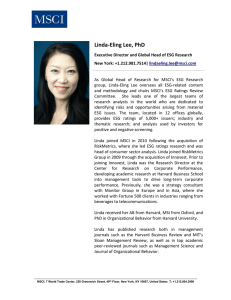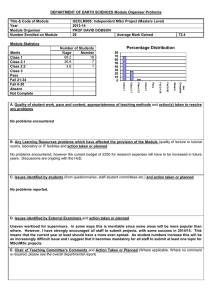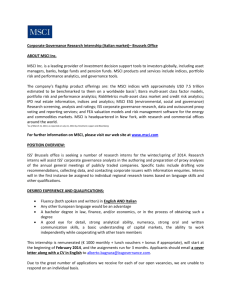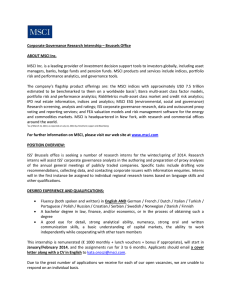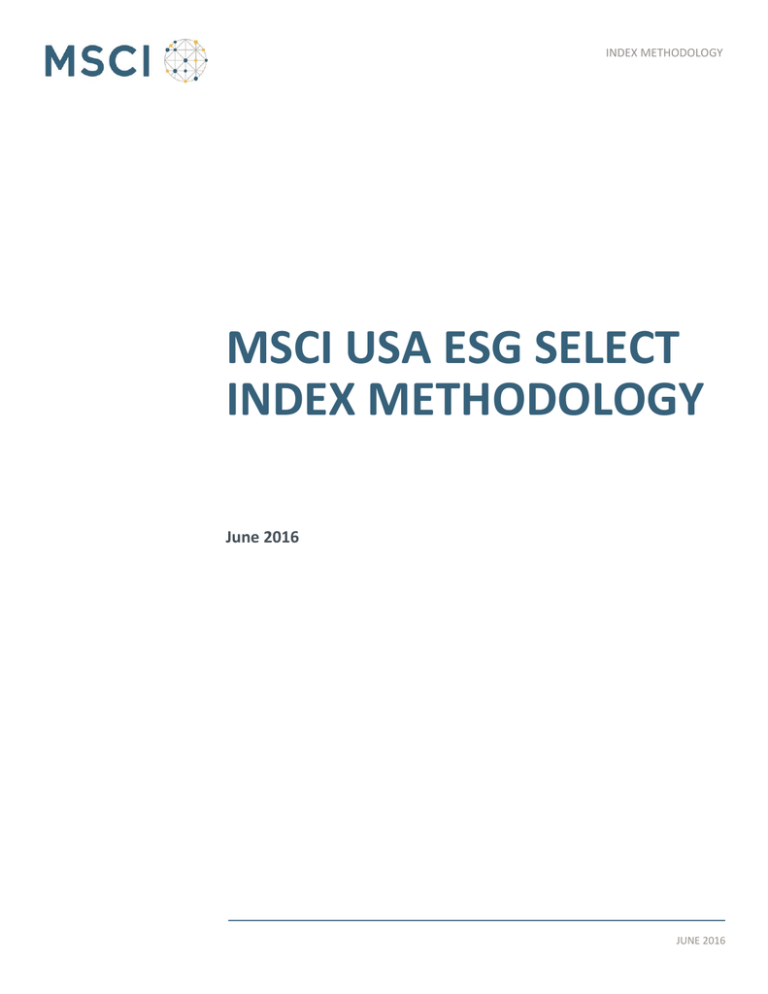
INDEX METHODOLOGY
MSCI USA ESG SELECT
INDEX METHODOLOGY
June 2016
JUNE 2016
MSCI USA ESG SELECT INDEX METHODOLOGY | JUNE 2016
CONTENTS
1
Introduction ................................................................................ 3
2
MSCI ESG Research framework ................................................... 4
3
4
2.1
MSCI ESG Ratings ..................................................................................... 4
2.2
MSCI ESG Controversies ........................................................................... 4
2.3
MSCI ESG Business Involvement Screening Research.............................. 5
Constructing the MSCI USA ESG Select Index .............................. 6
3.1
Defining the Parent Index ........................................................................ 6
3.2
Defining the exclusion criteria ................................................................. 6
3.2.1
Controversial Business Involvement criteria ....................................................6
3.2.2
Values-Based Exclusions ...................................................................................6
3.2.3
MSCI ESG Controversies Score Eligiblity ...........................................................7
3.3
Defining the optimization constraints...................................................... 7
3.4
Determining the optimized portfolio ....................................................... 8
Maintaining the MSCI USA ESG Select Index ............................... 9
4.1
Quarterly Index Reviews .......................................................................... 9
4.2
Ongoing Event-Related Maintenance ...................................................... 9
Appendix 1: Tobacco Exclusion Criteria............................................ 10
Appendix 2: Handling Infeasible Optimizations ................................ 11
Appendix 3: Methodology Transition ............................................... 12
Appendix 4: Controversial Business Screening Criteria .................... 13
© 2016 MSCI Inc. All rights reserved. Please refer to the disclaimer at the end of this document.
MSCI.COM | PAGE 2 OF 17
MSCI USA ESG SELECT INDEX METHODOLOGY | JUNE 2016
1
INTRODUCTION
The MSCI USA ESG Select Index is designed to maximize exposure to positive environmental,
social and governance (ESG) factors while exhibiting risk and return characteristics similar to
those of the MSCI USA Index. The Index is sector-diversified and targets high ESG ratings in
each sector. Relative to the MSCI USA Index, the MSCI USA ESG Select Index tends to overweight companies with higher ESG ratings and under-weight companies with lower ratings.
Tobacco companies are not eligible for inclusion into the Index.
© 2016 MSCI Inc. All rights reserved. Please refer to the disclaimer at the end of this document.
MSCI.COM | PAGE 3 OF 17
MSCI USA ESG SELECT INDEX METHODOLOGY | JUNE 2016
2
MSCI ESG RESEARCH FRAMEWORK
MSCI ESG Research provides in-depth research, ratings and analysis of the environmental,
social and governance-related business practices of thousands of companies worldwide. It
consists of an integrated suite of tools and products to efficiently manage research, analysis
and compliance tasks across the spectrum of ESG factors.
The MSCI USA ESG Select Index uses company ratings and research provided by MSCI ESG
Research. In particular, this index uses the following three MSCI ESG Research products:
MSCI ESG Ratings, MSCI ESG Controversies Score, and MSCI ESG Business Involvement
Screening Research.
For details on MSCI ESG Research’s full suite of ESG products, please refer to:
http://www.msci.com/products/esg/about_msci_esg_research.html
2.1
MSCI ESG RATINGS
MSCI ESG Ratings provides research, analysis and ratings of how well companies manage
environmental, social and governance risks and opportunities.
MSCI ESG Ratings provides an overall company ESG rating - a seven point scale from ‘AAA’ to
‘CCC’. In addition, the product provides scores and percentiles indicating how well a
company manages each key issue relative to industry peers.
For more details on MSCI ESG Ratings, please refer to
https://www.msci.com/documents/1296102/1636401/MSCI_ESG_Ratings.pdf
2.2
MSCI ESG CONTROVERSIES
MSCI ESG Controversies (earlier known as MSCI Impact Monitor) provides assessments of
controversies concerning the negative environmental, social, and/or governance impact of
company operations, products and services. The evaluation framework used in MSCI ESG
Controversies is designed to be consistent with international norms represented by the UN
Declaration of Human Rights, the ILO Declaration on Fundamental Principles and Rights at
Work, and the UN Global Compact. MSCI ESG Controversies Score falls on a 0-10 scale, with
“0” being the most severe controversy.
For more details on MSCI ESG Controversies Score, please refer to
https://www.msci.com/documents/10199/acbe7c8a-a4e4-49de-9cf8-5e957245b86b
© 2016 MSCI Inc. All rights reserved. Please refer to the disclaimer at the end of this document.
MSCI.COM | PAGE 4 OF 17
MSCI USA ESG SELECT INDEX METHODOLOGY | JUNE 2016
2.3
MSCI ESG BUSINESS INVOLVEMENT SCREENING RESEARCH
MSCI ESG Business Involvement Screening Research (BISR) aims to enable institutional
investors to manage environmental, social and governance (ESG) standards and restrictions
reliably and efficiently.
For more details on MSCI ESG Business Involvement Screening Research, please refer to
http://www.msci.com/resources/factsheets/MSCI_ESG_BISR.pdf
© 2016 MSCI Inc. All rights reserved. Please refer to the disclaimer at the end of this document.
MSCI.COM | PAGE 5 OF 17
MSCI USA ESG SELECT INDEX METHODOLOGY | JUNE 2016
3
CONSTRUCTING THE MSCI USA ESG SELECT INDEX
Constructing the MSCI USA ESG Select Index involves the following steps:
3.1
Defining the underlying MSCI Parent Index (‘Parent Index’);
Defining the exclusion criteria;
Defining the optimization constraints; and
Determining the optimized portfolio
DEFINING THE PARENT INDEX
The Parent Index for the MSCI USA ESG Select Index is the MSCI USA Index, excluding any
stocks with Tobacco involvement. Please refer to Appendix 1 for more details on this
criterion.
3.2
DEFINING THE EXCLUSION CRITERIA
3.2.1
CONTROVERSIAL BUSINESS INVOLVEMENT CRITERIA
Companies that are involved in specific businesses which have high potential for negative
social and/or environmental impact are ineligible for inclusion in the index. Please refer to
Appendix 4 for more details on these criteria.
3.2.2
Alcohol
Gambling
Nuclear Power
Conventional and Controversial Weapons
Civilian Firearms
VALUES-BASED EXCLUSIONS
MSCI USA ESG Select Index uses MSCI ESG Business Involvement Screening Research to
identify companies with Tobacco involvement. Companies that meet this criteria are
excluded from the MSCI USA ESG Select Index. Please refer to Appendix 1 for details on
these criteria.
© 2016 MSCI Inc. All rights reserved. Please refer to the disclaimer at the end of this document.
MSCI.COM | PAGE 6 OF 17
MSCI USA ESG SELECT INDEX METHODOLOGY | JUNE 2016
3.2.3
MSCI ESG CONTROVERSIES SCORE ELIGIBLITY
The MSCI USA ESG Select Index uses MSCI ESG Controversies Scores to identify those
companies that are involved in very serious controversies involving the environmental,
social, or governance impact of their operations and/or products and services. Existing
constituents of the MSCI USA ESG Select Index are required to have an MSCI ESG
Controversies Score above 0 to remain in the index, while companies that are currently not
constituents of the MSCI USA ESG Select Index are required to have an MSCI ESG
Controversies Score above 2 to be considered eligible for addition.
3.3
DEFINING THE OPTIMIZATION CONSTRAINTS
Constituents are selected to maximize exposure to industry adjusted ESG Scores, subject to
maintaining risk and return characteristics similar to the MSCI USA Index. ESG Scores are
normalized and factored into the optimization process. Optimization is a quantitative
process that considers the market capitalization weights from the MSCI USA Index, ESG
Scores and additional optimization constraints to select and weight the constituents in the
Index.
Normalization of the ESG Scores allows the optimization to assess each score in the context
of the overall distribution of the ESG Scores.
At each Quarterly Index Review, the following optimization constraints are used to ensure
replicability and investability:
The predicted tracking error is restricted to 1.8%
The maximum weight of an index constituent will be 5%;
The minimum weight of an index constituent will be 0.1%;
The number of index constituents is constrained to a maximum of 350;
The sector weights of the MSCI USA ESG Select Index will not deviate by more than +/3% from the sector weights of the MSCI USA Index;
The one way turnover of the MSCI USA ESG Select Index is constrained to a maximum of
10% at Semi-Annual Index Reviews and 5% at Quarterly Index Reviews;
One way transaction cost is set to 0.5% which aims to achieve a balance between
turnover and ESG Scores; and
An AS/CF (Asset Selection/Common Factor) Risk Aversion Ratio of 10 is applied.
Please refer to the Appendix 2 for the description of the handling of infeasible
optimizations.
© 2016 MSCI Inc. All rights reserved. Please refer to the disclaimer at the end of this document.
MSCI.COM | PAGE 7 OF 17
MSCI USA ESG SELECT INDEX METHODOLOGY | JUNE 2016
3.4
DETERMINING THE OPTIMIZED PORTFOLIO
The MSCI USA ESG Select Index is constructed using the most recent release of the Barra
Open Optimizer in combination with the relevant Barra Equity Model. The optimization uses
the MSCI USA Index after application of the exclusion criteria as described in section 3.2
above, as the universe of eligible securities and the specified optimization objective and
constraints to determine the constituents of the MSCI USA ESG Select Index.
© 2016 MSCI Inc. All rights reserved. Please refer to the disclaimer at the end of this document.
MSCI.COM | PAGE 8 OF 17
MSCI USA ESG SELECT INDEX METHODOLOGY | JUNE 2016
4
MAINTAINING THE MSCI USA ESG SELECT INDEX
4.1
QUARTERLY INDEX REVIEWS
The MSCI USA ESG Select Index is rebalanced on a quarterly basis to coincide with the
regular Index Reviews (Semi-Annual Index Reviews in May and November and Quarterly
Index Reviews in February and August) of the MSCI Global Investable Market Indexes. The
changes are implemented at the end of February, May, August and November. The pro
forma indexes are in general announced nine business days before the effective date.
ESG scores used for the Quarterly Index Reviews will be taken as of the end of the month
preceding the Index Review, i.e., January, April, July and October.
At each Index Review, the optimization process outlined in Section 3 is implemented.
Companies can only be added to the MSCI USA ESG Select Index at regular Index Reviews.
4.2
ONGOING EVENT-RELATED MAINTENANCE
In general, the MSCI USA ESG Select Index follows the event maintenance of the MSCI USA
Index.
New additions to the MSCI USA Index due to corporate events will not be added
simultaneously to the MSCI USA ESG Select Index, but will be considered for inclusion at the
following Index Review. Companies deleted from the MSCI USA Index between Index
Reviews due to corporate events maintenance are also deleted at the same time from the
MSCI USA ESG Select Index.
The technical details relating to the handling of specific corporate event types can be found
in the MSCI Corporate Events Methodology book available at:
http://www.msci.com/products/indexes/size/standard/methodology.html
© 2016 MSCI Inc. All rights reserved. Please refer to the disclaimer at the end of this document.
MSCI.COM | PAGE 9 OF 17
MSCI USA ESG SELECT INDEX METHODOLOGY | JUNE 2016
APPENDIX 1: TOBACCO EXCLUSION CRITERIA
Companies which meet the following Tobacco involvement criteria are excluded from the
MSCI USA ESG Select Index
All companies classified as “Producer” or “Licensor”
All companies classified as “Distributor”, “Retailer”, or “Supplier” that earn 15% or more
of revenues from tobacco products
All companies classified as “Ownership by a Tobacco Company” or “Ownership of a
Tobacco Company”
© 2016 MSCI Inc. All rights reserved. Please refer to the disclaimer at the end of this document.
MSCI.COM | PAGE 10 OF 17
MSCI USA ESG SELECT INDEX METHODOLOGY | JUNE 2016
APPENDIX 2: HANDLING INFEASIBLE OPTIMIZATIONS
During the Quarterly Index Review, in the event that there is no optimal solution that
satisfies all the optimization constraints defined in Section 3.3, the tracking error will be
relaxed in steps of 0.2% until an optimal solution is found.
© 2016 MSCI Inc. All rights reserved. Please refer to the disclaimer at the end of this document.
MSCI.COM | PAGE 11 OF 17
MSCI USA ESG SELECT INDEX METHODOLOGY | JUNE 2016
APPENDIX 3: METHODOLOGY TRANSITION
May 2012 – May 2013
The MSCI USA ESG Select Index transitioned to the methodology described in the above
document starting from the May 2012 Index Review. As part of the enhancements to the
MSCI USA ESG Select Index Methodology, the annual turnover budget is reduced from 50%
to 30% (10% at Semi-Annual Index Reviews and 5% at Quarterly Index Reviews). The lower
annual turnover budget of 30% will be applied starting from the May 2012 Index Review.
May 2016
Effective at the May 2016 Index Review, the MSCI USA ESG Select Index transitioned to the
methodology described in the methodology book, following enhancements to the MSCI ESG
Controversies (earlier known as MSCI Impact Monitor). The details of the changes are as
given below.
The changes to MSCI ESG Controversies included adjusting the scoring model to align the
scores with individual controversy case levels, including the introduction of an Orange flag,
and the removal of specific controversial business involvement (CBI) criteria from the model
to refocus the ESG Controversies scores on event-driven controversies.
MSCI implemented the following changes to the MSCI USA ESG Select Index methodology
effective June 1, 2016 to maintain consistency with the existing index construction
objectives:
1 - As per the old MSCI ESG Impact Monitor methodology, securities which had an Impact
Monitor score of 0 and 1 had a Red controversy flag. Under the new methodology, only
securities with an ESG controversies score of 0 have a Red controversy flag. For indexes
where constituents were ineligible to be included in the index if their Impact Monitor score
was 0 or 1 (current Red controversy flag), the exclusion criteria was changed to ESG
Controversies score = 0 in order to continue to only exclude securities with Red controversy
flag in the MSCI USA ESG Select Index.
2 - Additional exclusion rules based on the controversial business involvement criteria
related to alcohol, gambling, nuclear power, conventional weapons and controversial
weapons that were incorporated in the old MSCI Impact Monitor scores were introduced as
part of the methodology of the MSCI USA ESG Select Index. Since, the rule for exclusion of
securities with tobacco involvement was already more stringent in MSCI USA ESG Select
methodology, it was not included. The details of the exclusion rules are mentioned in
Appendix 4.
© 2016 MSCI Inc. All rights reserved. Please refer to the disclaimer at the end of this document.
MSCI.COM | PAGE 12 OF 17
MSCI USA ESG SELECT INDEX METHODOLOGY | JUNE 2016
APPENDIX 4: CONTROVERSIAL BUSINESS SCREENING CRITERIA
Companies that are involved in certain controversial business activities are ineligible to be
included in the MSCI USA ESG Select Index because of the high potential for negative social
and/or environmental impacts of these activities. The details for the ineligibility criteria are
as follows –
Alcohol
-
Gambling
-
All companies classified as involved in “Operations” and “Support” that earn 50% or
more in revenue, or more than $1 billion in revenue, from gambling-related
products
Nuclear Power
-
All companies involved in nuclear fuel enrichment for nuclear power generation
-
All companies involved in uranium mining for nuclear power generation
-
All companies involved in nuclear reactor design or construction for nuclear power
generation
-
All companies with 6000 MW or more of installed capacity attributed to nuclear
sources or with 50% or more of installed capacity attributed to nuclear sources
Conventional Weapons
-
All companies classified as a “Producer” that earn either 50% or more revenue or
more than $1 billion in revenue from alcohol-related products.
All companies that manufacture conventional weapons components or
conventional weapons and weapons systems and earn 50% or more in revenue, or
$3 billion or more in revenue from these activities
Controversial Weapons
-
Cluster munitions manufacturers
-
Landmines manufacturers
-
Depleted Uranium Weapons manufacturers
-
All companies involved in manufacturing of nuclear weapon components or nuclear
weapon systems
-
All companies involved in manufacturing of bio-chemical weapon components or
bio-chemical weapon systems
© 2016 MSCI Inc. All rights reserved. Please refer to the disclaimer at the end of this document.
MSCI.COM | PAGE 13 OF 17
MSCI USA ESG SELECT INDEX METHODOLOGY | JUNE 2016
Civilian Firearms
-
All companies classified as a “Producer” that earn either 50% or more revenue or
more than $100 million in revenue from civilian firearms
© 2016 MSCI Inc. All rights reserved. Please refer to the disclaimer at the end of this document.
MSCI.COM | PAGE 14 OF 17
MSCI USA ESG SELECT INDEX METHODOLOGY | JUNE 2016
The following sections have been modified since February 2013:
Section 3.2.1: Controversial Business Involvement criteria
Added section
Section 3.2.3: ESG Controversies Score Eligibility
Updated the MSCI ESG Controversies Score eligibility requirements
Appendix 3: Methodology Transition
Added details pertaining to the methodology changes effective as of May 2016
Appendix 4: Controversial Business Screening Criteria
The following sections have been modified since May 2016:
Section 3.2.1: Controversial Business Involvement criteria
Added Civilian Firearms to the list of controversial business involvement criteria
Appendix 4: Controversial Business Screening Criteria
Addition of the controversial business screening criteria pertaining to Civilian
Firearms
© 2016 MSCI Inc. All rights reserved. Please refer to the disclaimer at the end of this document.
MSCI.COM | PAGE 15 OF 17
MSCI USA ESG SELECT INDEX METHODOLOGY | JUNE 2016
CONTACT US
clientservice@msci.com
AMERICAS
Americas
Atlanta
Boston
Chicago
Monterrey
New York
San Francisco
Sao Paulo
Toronto
ABOUT MSCI
1 888 588 4567 *
+ 1 404 551 3212
+ 1 617 532 0920
+ 1 312 675 0545
+ 52 81 1253 4020
+ 1 212 804 3901
+ 1 415 836 8800
+ 55 11 3706 1360
+ 1 416 628 1007
EUROPE, MIDDLE EAST & AFRICA
Cape Town
Frankfurt
Geneva
London
Milan
Paris
+ 27 21 673 0100
+ 49 69 133 859 00
+ 41 22 817 9777
+ 44 20 7618 2222
+ 39 02 5849 0415
0800 91 59 17 *
For more than 40 years, MSCI’s researchbased indexes and analytics have helped
the world’s leading investors build and
manage better portfolios. Clients rely on
our offerings for deeper insights into the
drivers of performance and risk in their
portfolios, broad asset class coverage and
innovative research.
Our line of products and services includes
indexes, analytical models, data, real estate
benchmarks and ESG research.
MSCI serves 98 of the top 100 largest
money managers, according to the most
recent P&I ranking.
For more information, visit us at
www.msci.com.
ASIA PACIFIC
China North
China South
Hong Kong
Mumbai
Seoul
Singapore
Sydney
Taipei
Tokyo
10800 852 1032 *
10800 152 1032 *
+ 852 2844 9333
+ 91 22 6784 9160
00798 8521 3392 *
800 852 3749 *
+ 61 2 9033 9333
008 0112 7513 *
+ 81 3 5290 1555
* = toll free
© 2016 MSCI Inc. All rights reserved. Please refer to the disclaimer at the end of this document.
MSCI.COM | PAGE 16 OF 17
MSCI USA ESG SELECT INDEX METHODOLOGY | JUNE 2016
NOTICE AND
DISCLAIMER
This document and all of the information contained in it, including without limitation all text, data, graphs, charts (collectively, the “Information”) is
the property of MSCI Inc. or its subsidiaries (collectively, “MSCI”), or MSCI’s licensors, direct or indirect suppliers or any third party involved in making
or compiling any Information (collectively, with MSCI, the “Information Providers”) and is provided for informational purposes only. The Information
may not be modified, reverse-engineered, reproduced or redisseminated in whole or in part without prior written permission from MSCI.
The Information may not be used to create derivative works or to verify or correct other data or information. For example (but without limitation),
the Information may not be used to create indexes, databases, risk models, analytics, software, or in connection with the issuing, offering,
sponsoring, managing or marketing of any securities, portfolios, financial products or other investment vehicles utilizing or based on, linked to,
tracking or otherwise derived from the Information or any other MSCI data, information, products or services.
The user of the Information assumes the entire risk of any use it may make or permit to be made of the Information. NONE OF THE INFORMATION
PROVIDERS MAKES ANY EXPRESS OR IMPLIED WARRANTIES OR REPRESENTATIONS WITH RESPECT TO THE INFORMATION (OR THE RESULTS TO BE
OBTAINED BY THE USE THEREOF), AND TO THE MAXIMUM EXTENT PERMITTED BY APPLICABLE LAW, EACH INFORMATION PROVIDER EXPRESSLY
DISCLAIMS ALL IMPLIED WARRANTIES (INCLUDING, WITHOUT LIMITATION, ANY IMPLIED WARRANTIES OF ORIGINALITY, ACCURACY, TIMELINESS,
NON-INFRINGEMENT, COMPLETENESS, MERCHANTABILITY AND FITNESS FOR A PARTICULAR PURPOSE) WITH RESPECT TO ANY OF THE
INFORMATION.
Without limiting any of the foregoing and to the maximum extent permitted by applicable law, in no event shall any Information Provider have any
liability regarding any of the Information for any direct, indirect, special, punitive, consequential (including lost profits) or any other damages even if
notified of the possibility of such damages. The foregoing shall not exclude or limit any liability that may not by applicable law be excluded or limited,
including without limitation (as applicable), any liability for death or personal injury to the extent that such injury results from the negligence or
willful default of itself, its servants, agents or sub-contractors.
Information containing any historical information, data or analysis should not be taken as an indication or guarantee of any future performance,
analysis, forecast or prediction. Past performance does not guarantee future results.
The Information should not be relied on and is not a substitute for the skill, judgment and experience of the user, its management, employees,
advisors and/or clients when making investment and other business decisions. All Information is impersonal and not tailored to the needs of any
person, entity or group of persons.
None of the Information constitutes an offer to sell (or a solicitation of an offer to buy), any security, financial product or other investment vehicle or
any trading strategy.
It is not possible to invest directly in an index. Exposure to an asset class or trading strategy or other category represented by an index is only
available through third party investable instruments (if any) based on that index. MSCI does not issue, sponsor, endorse, market, offer, review or
otherwise express any opinion regarding any fund, ETF, derivative or other security, investment, financial product or trading strategy that is based on,
linked to or seeks to provide an investment return related to the performance of any MSCI index (collectively, “Index Linked Investments”). MSCI
makes no assurance that any Index Linked Investments will accurately track index performance or provide positive investment returns. MSCI Inc. is
not an investment adviser or fiduciary and MSCI makes no representation regarding the advisability of investing in any Index Linked Investments.
Index returns do not represent the results of actual trading of investible assets/securities. MSCI maintains and calculates indexes, but does not
manage actual assets. Index returns do not reflect payment of any sales charges or fees an investor may pay to purchase the securities underlying the
index or Index Linked Investments. The imposition of these fees and charges would cause the performance of an Index Linked Investment to be
different than the MSCI index performance.
The Information may contain back tested data. Back-tested performance is not actual performance, but is hypothetical. There are frequently
material differences between back tested performance results and actual results subsequently achieved by any investment strategy.
Constituents of MSCI equity indexes are listed companies, which are included in or excluded from the indexes according to the application of the
relevant index methodologies. Accordingly, constituents in MSCI equity indexes may include MSCI Inc., clients of MSCI or suppliers to MSCI. Inclusion
of a security within an MSCI index is not a recommendation by MSCI to buy, sell, or hold such security, nor is it considered to be investment advice.
Data and information produced by various affiliates of MSCI Inc., including MSCI ESG Research Inc. and Barra LLC, may be used in calculating certain
MSCI indexes. More information can be found in the relevant index methodologies on www.msci.com.
MSCI receives compensation in connection with licensing its indexes to third parties. MSCI Inc.’s revenue includes fees based on assets in Index
Linked Investments. Information can be found in MSCI Inc.’s company filings on the Investor Relations section of www.msci.com.
MSCI ESG Research Inc. is a Registered Investment Adviser under the Investment Advisers Act of 1940 and a subsidiary of MSCI Inc. Except with
respect to any applicable products or services from MSCI ESG Research, neither MSCI nor any of its products or services recommends, endorses,
approves or otherwise expresses any opinion regarding any issuer, securities, financial products or instruments or trading strategies and MSCI’s
products or services are not intended to constitute investment advice or a recommendation to make (or refrain from making) any kind of investment
decision and may not be relied on as such. Issuers mentioned or included in any MSCI ESG Research materials may include MSCI Inc., clients of MSCI
or suppliers to MSCI, and may also purchase research or other products or services from MSCI ESG Research. MSCI ESG Research materials, including
materials utilized in any MSCI ESG Indexes or other products, have not been submitted to, nor received approval from, the United States Securities
and Exchange Commission or any other regulatory body.
Any use of or access to products, services or information of MSCI requires a license from MSCI. MSCI, Barra, RiskMetrics, IPD, FEA, InvestorForce, and
other MSCI brands and product names are the trademarks, service marks, or registered trademarks of MSCI or its subsidiaries in the United States
and other jurisdictions. The Global Industry Classification Standard (GICS) was developed by and is the exclusive property of MSCI and Standard &
Poor’s. “Global Industry Classification Standard (GICS)” is a service mark of MSCI and Standard & Poor’s.
© 2015 MSCI Inc. All rights reserved.
MSCI.COM | PAGE 17 OF 17

